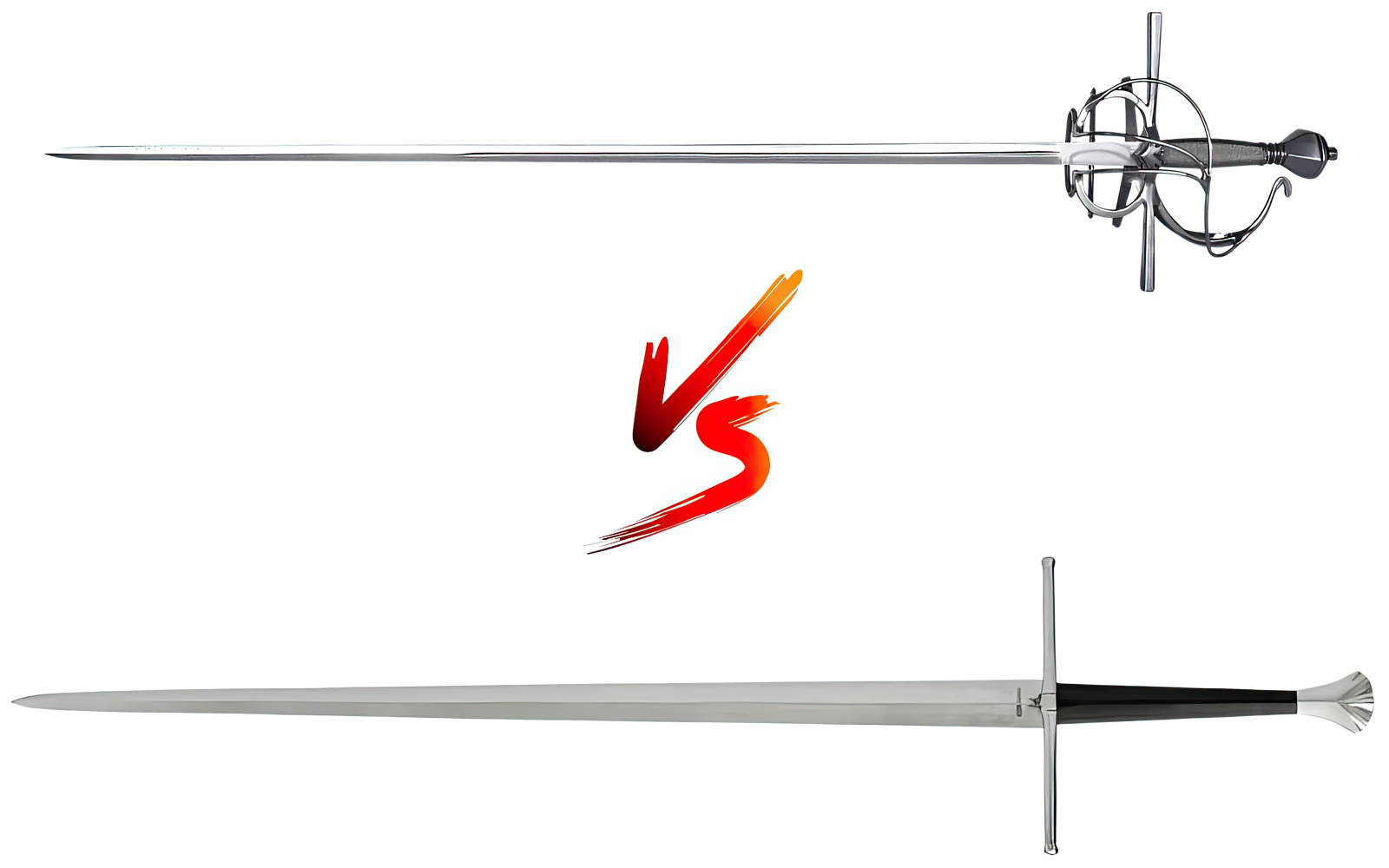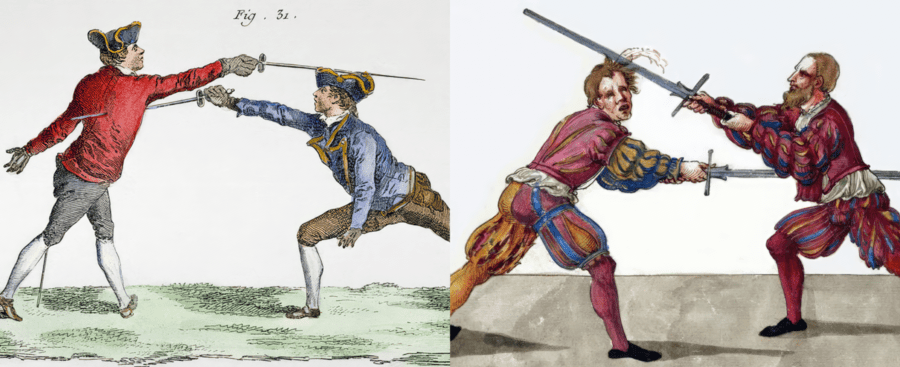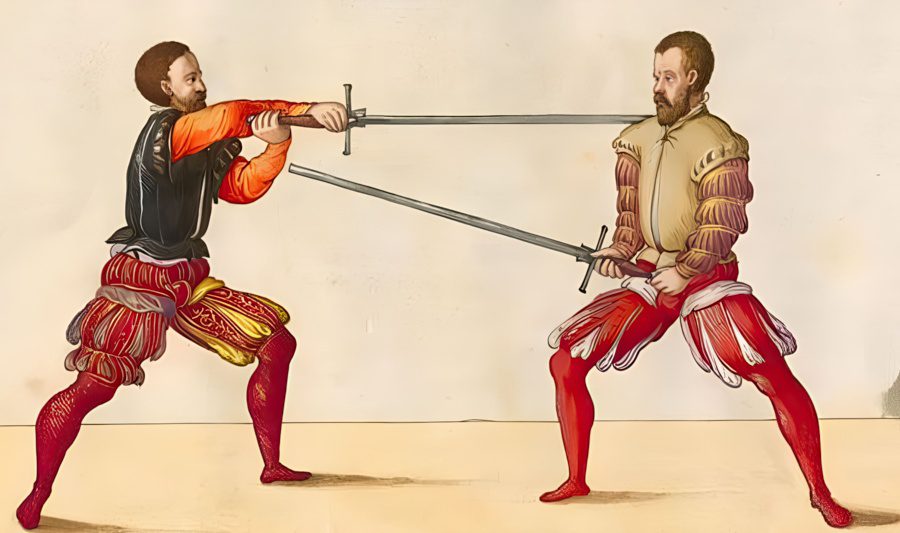Rapier vs Longsword: Which is the Superior Dueling Weapon?
NO AI USED This Article has been written and edited by our team with no help of the AI

Both the rapier and longsword are iconic European blades that are popular in modern HEMA (Historical European Martial Arts) training. But which is the better dueling weapon?
In this article, we pit the longsword and rapier against each other in different scenarios. We examine their fighting performance capabilities and historical usefulness and conclude by declaring a winner.
Design Differences

Both the longsword and the rapier are straight and double-edged.
The rapier’s blade type can vary but it’s generally very slim with a pointy tip. It has an optional fuller, which reduces its weight.
The one-handed hilt features a complex steel guard, which can include long straight quillons, a cup, or smaller quillons in a design called a swept hilt.
A swept hilt has multiple bars or loops that curve around the handle, providing extra hand protection.
There are many types of longsword, some with acute tips and others with rounded ones. The longsword can have one or more fullers, or a mid-rib, to reduce its weight.
It has a long crossguard, which is sometimes curved but most often straight. It is a two-handed weapon with a simple wooden handle wrapped in leather and a mostly rounded pommel.
Fighting Scenarios
To better understand the similarities and differences between the rapier and longsword, it is important to consider how they compare in different combat scenarios.
A Fight to the Death – Longsword (Winner)

In a fight to the death, the fighter with superior versatility, power, and reach advantage will emerge victorious. The longsword is the superior choice here. It’s effective for attacking from a distance or up close, for hand-to-hand combat, and in both open and tight spaces.
What’s more, an opponent might be struck by a rapier and yet still be able to fight on. A blow from a longsword, meanwhile, is likely to be decisive.

If a rapier is used alongside a shield, the odds shift significantly in the bearer’s favor.
“The shield is forgotten by many, but the fact is that the shield is in many rapier treatises.”, says Matt Easton, instructor and founder of the HEMA group, Scholagladiatoria.
Dueling with Rules – Rapier (Winner)

In some situations, combat rules forbid close fighting or charging at the opponent and limit how the blade can move. The rapier was essentially created for and excels in such situations.
Its slim form and long-range offer high precision and the ability to outperform the longsword with quick movements such as thrust attacks due to its speed and unpredictability. Its protective handguard allows for good defense, especially when wielded alongside a dagger.
The Battlefield – Longsword (Winner)

The longsword is well suited to the battlefield. It’s effective against both light and heavy armor. It can be sheathed and carried like a regular sword to be used as a secondary weapon alongside a halberd. Alternatively, it can be used unsheathed as a soldier’s primary weapon. Its weight and maneuverability make it effective both against cavalry and when facing multiple opponents.
In contrast, the rapier has limited utility in such scenarios. It doesn’t work well in a formation and it’s a bad option when faring against any type of armor. Its design makes it less versatile for fighting multiple enemies on the battlefield.
“First I will begin with the worst weapon, an imperfect and insufficient weapon and not worth speaking of, but now being highly esteemed, therefore not to be unremembered.”, says George Silver, a 17th-century fencer known for his writings on swordplay, on the rapier’s inappropriateness in war.
Fighting Performance Compared

So far we’ve seen how these two weapons perform in particular combat scenarios. But we can also compare them with respect to the following characteristics:
- Cutting
- Thrusting
- Speed & Reach Advantage
- Dealing with Armor
- Durability & Defense
- Versatility & Adaptability
1. Cutting – Longsword (Winner)
Cutting involves attacking with the sharpened sides of a blade.
The design of the longsword’s longer blade taper, together with the weapon’s two-handed hilt, allows the swordsman to generate greater power and spread the impact more effectively. The longsword can slice and sometimes chop directly through parts of the human body.
While the cutting power of the rapier shouldn’t be underestimated, the weapon cuts primarily with its tip. The rapier’s tip won’t penetrate as deeply as the longsword and it can be blocked even by certain types of armor/clothing.
2. Thrusting – Rapier (Winner)

The rapier has a thin, pointy design with two sharpened edges. It can enter its target easily and be driven deeper with a simple thrust of the handle. While it creates a smaller entry wound, the rapier can penetrate deeply and cause massive internal bleeding.
The longsword is also ideal for thrusting and can potentially do more initial damage due to its design. However, a swordsman armed with a rapier can perform a deadly thrust with a single hand and much less energy, making it overall a superior thrusting weapon.
3. Speed & Reach Advantage – Tie
The rapier is capable of a much faster thrust due to the posture of the rapierist, which allows for quick extensions and fast attacks. This posture also makes the rapierist a harder target to hit and provides a range advantage, especially in thrusting attacks.
The longsword can also be held in this posture, but it requires both hands for maximum versatility. Its unique grip motions and two-handed nature allow for greater maneuverability and faster recovery time after each cutting strike. Due to the longer handle, it can thrust the same distance as a rapier.
Ultimately, the speed, dexterity, and reach advantage depend on the wielder’s experience.
4. Against Armor – Longsword (Winner)

The longsword emerged and evolved at a time when plate armor was changing the way that battles were fought in Europe. Its sleek blade could be held with a hand and navigated through gaps in armor, using a technique called half-swording. This made it one of the best anti-armor melee weapons.
The rapier is ineffective against many types of armor. Even padded gloves are difficult for the rapier’s blade to overcome.
5. Durability & Defense – Longsword (Winner)

The longsword affords a much more powerful strike when compared to the rapier. If the blade strikes the rapier’s guard, it can damage the rapierist’s hands, forcing them to resort to evasive strategies.
The blade of the longsword is wider, allowing it to be reinforced with a mid-rib or wider fuller for elasticity, which provides greater durability.
6. Versatility & Adaptability – Longsword (Winner)

Because the rapier is one-handed and has a fairly closed guard, the wielder’s motions are limited. Its slim blade is primarily designed for deep thrusting and light cutting. It can be carried more easily than the longsword due to its slightly smaller size, but this can sometimes be problematic due to its long blade.
When used alongside a second rapier, a short sword, dagger, shield, or buckler, the rapier can offer some very unique and versatile fighting styles.
The longsword, in comparison, is a genuine jack of all trades. Depending on the blade design, it can be used for either powerful thrusting, slashing, or both. Additionally, it can be used as a dagger for quick stabbing attacks or for bashing using the pommel.
Rapiers are ideal for one-on-one duels where some distance is maintained between the fighters. Longswords, meanwhile, make for effective weapons in a variety of situations.
The Combat History of the Rapier and Longsword

These two swords overlapped briefly in the Middle Ages and the Renaissance. The longsword was replaced by the greatsword on the battlefield, and by the rapier in everyday life.
Only a few historical sources, like Gerard Thibault of Antwerp, a 16th-century fencer, describe combat between the longsword and the rapier. They remain among the most studied swords in historical fencing arts such as HEMA.
Rapier

- Date: 16th to 18th century
- Primary Use: Everyday life, dueling
The rapier evolved from the earlier sidesword and incorporated many of its combative elements. It rarely saw use as a primary weapon on the battlefield and instead was sheathed and carried like a secondary. During the 17th century, its primary combat focus was thrusting.
The rapier was used in everyday life to settle disputes through duels. Despite some legal restrictions, it became socially accepted in the 16th century and a vital part of the European dress code.
It subsequently gained popularity within popular fencing styles such as Italian and Spanish forms and with notable figures like Camillo Agrippa and Ridolfo Capoferro.
Longsword

- Date: 13th to 17th century.
- Primary Use: Battlefield, everyday life, dueling
The longsword was a larger two-handed version of the knightly arming sword. From the 13th century, and especially throughout the 14th and 15th centuries, it was used to combat plate armor. It was both a primary and secondary weapon of war, which played a significant role in many historical battles.
It evolved over time in response to developments in armor. As a cutting implement, it functioned similarly to the traditional Viking sword. Its later designs emphasized cut-and-thrust weapon traits and went on to inspire the rapier.
When its owner was not in battle, it was carried sheathed and was the norm before the rapier replaced it. It was popular for dueling and martial arts, especially among notable figures like Joachim Meyer and Johannes Liechtenauer.
Conclusion
The rapier and longsword both have their advantages and disadvantages. In a duel with rules, such as one-tap or first to bleed, they’re evenly matched. But if the rapierist is permitted to use a shield, the odds lean in their favor.
However, in a fight to the death and with only swords allowed, the longsword has a clear advantage, especially when the combatants are armored.





